22 Essential Ideas for a Cozy and Aesthetic Minimalist Living Room
In a world saturated with constant noise, notifications, and an endless accumulation of "stuff," the modern home is increasingly called upon to be more than just a shelter; it needs to be a sanctuary. This is the heart of the minimalist philosophy. Far from being a sterile, cold, or empty aesthetic, true minimalism is the intentional promotion of the things we value most and the removal of everything that distracts from them. When applied to your living room—the very heart of your home—this approach can create a space that is not only visually stunning but also deeply calming and restorative.
The goal is to design a room that breathes. A place where clean lines, thoughtful textures, and an uncluttered environment work in harmony to foster peace and connection. But how do you achieve this coveted blend of simplicity and warmth? How do you make "less" feel like so much more? This guide delves into 22 foundational ideas that will help you transform your living space into a cozy, aesthetic, and functional minimalist haven.
- The Architectural Foundation: Shaping Your Space with Grace and Light
- The Core Furnishings: Anchoring Your Room with Style and Comfort
- Layering Texture and Softness: The "Cozy" in Minimalist
- The Personal Touches: Art, Decor, and Storytelling
- Bringing Nature Indoors: The Final, Vital Layer
- Conclusion: Your Personal Minimalist Sanctuary
The Architectural Foundation: Shaping Your Space with Grace and Light
Before a single piece of furniture is chosen, the room's inherent structure sets the tone. By focusing on architectural elements and the core color palette, you create a perfect canvas for your minimalist design.
1. Embrace the Power of Simple White Walls

The quintessential starting point for any minimalist interior is a canvas of clean, white walls. This isn't about being boring; it's about being brilliant. White paint acts as a powerful light reflector, instantly making a space feel larger, brighter, and more open. It creates what designers call "negative space," an essential concept in minimalism that allows your chosen furniture and decor to truly shine without competing for attention. Consider a warm white, like Sherwin Williams' Pure White or Benjamin Moore's Swiss Coffee, which adds a subtle softness and prevents the room from feeling clinical.
 9 Modern Luxury Living Room Ideas You’ll Love – Elegant & Stylish Designs
9 Modern Luxury Living Room Ideas You’ll Love – Elegant & Stylish Designs2. Weave in Softness with Arched Doorways and Shelves
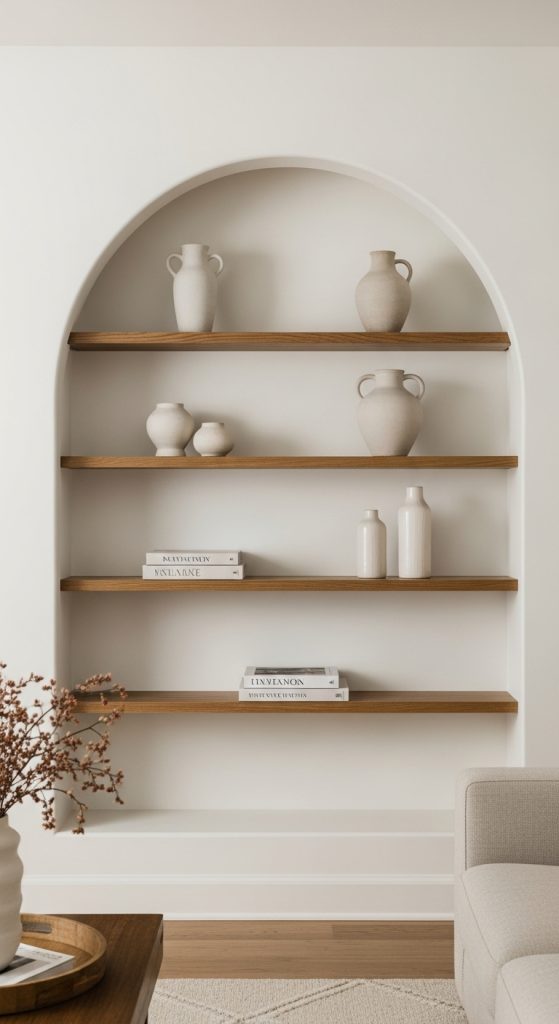
Minimalism often favors straight lines, but introducing curves can add a profound sense of grace and sophistication. Arched doorways or built-in arched shelving are stunning architectural features that soften the entire room. These gentle curves break up the rigidity of a space, creating an elegant, almost classical feel that remains timeless. If built-ins aren't an option, you can achieve a similar effect with a freestanding arched cabinet or bookcase, which serves as both a functional storage piece and a sculptural work of art.
3. Adopt a Classic White, Wood, and Black Color Scheme
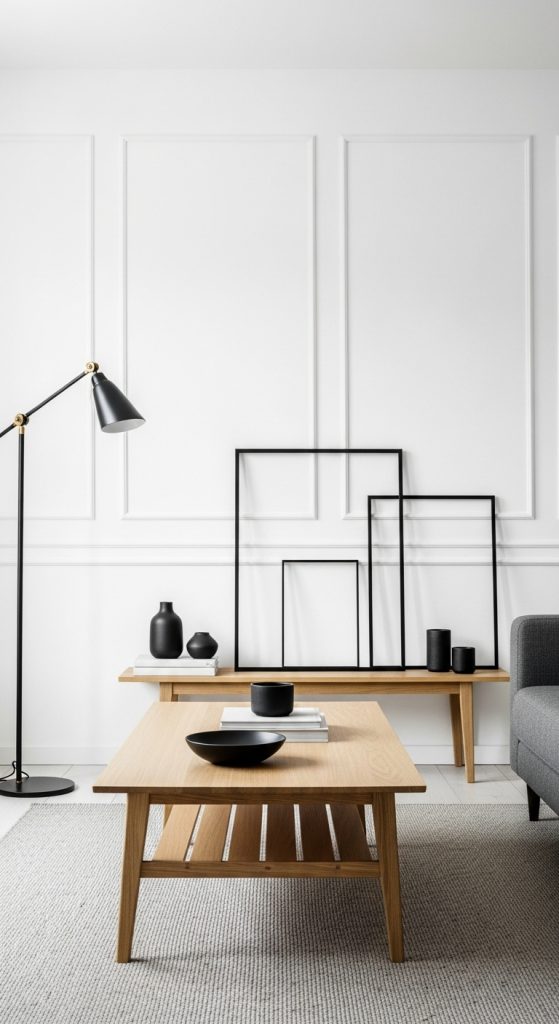
For a foolproof and eternally chic minimalist palette, you cannot go wrong with the triad of white, wood, and black. This combination is a masterclass in balance. The white provides the bright, airy base. The wood introduces essential warmth and natural texture. The black acts as a grounding element, providing a touch of drama and contrast that makes the other elements pop. Use this scheme in varying proportions: perhaps white walls, a light wood coffee table, and black accents in picture frames, a side table, or a floor lamp.
4. Establish a Calm Foundation with a Neutral Color Palette
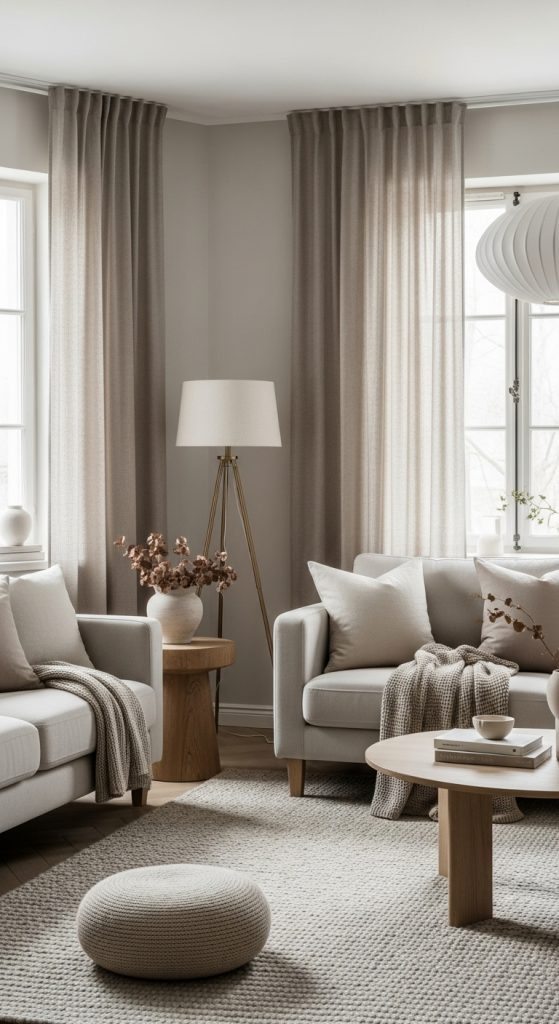
 17 Small Living Room Layouts That Maximize Space and Style
17 Small Living Room Layouts That Maximize Space and StyleIf you wish to move beyond pure white, a broader neutral color palette is your best friend. Think in shades of beige, cream, taupe, mushroom, and soft, light grays. These muted tones are inherently calming to the human eye, fostering a serene and peaceful atmosphere. The key to making a neutral room interesting is to layer various shades and textures. A beige sofa, a cream rug, and taupe curtains, for example, create a rich, tonal landscape that feels sophisticated and deeply comforting.
The Core Furnishings: Anchoring Your Room with Style and Comfort
The largest pieces in your living room dictate its function and feel. Choosing wisely is paramount. The focus should be on clean silhouettes, high-quality materials, and enduring comfort.
5. Opt for an Airy White Sectional Sofa

A sectional sofa is the ultimate piece for communal comfort, but a bulky, dark one can devour a room. A white or light-colored sectional, however, feels expansive and light. It provides ample seating without visually weighing down the space. Worried about stains? Modern performance fabrics are a game-changer, offering incredible durability and stain resistance, making a white sofa a practical choice for everyday life. Its neutral presence allows for flexibility, letting you change up throw pillows and blankets with the seasons.
6. Introduce Sophistication with a Grey Sectional Sofa
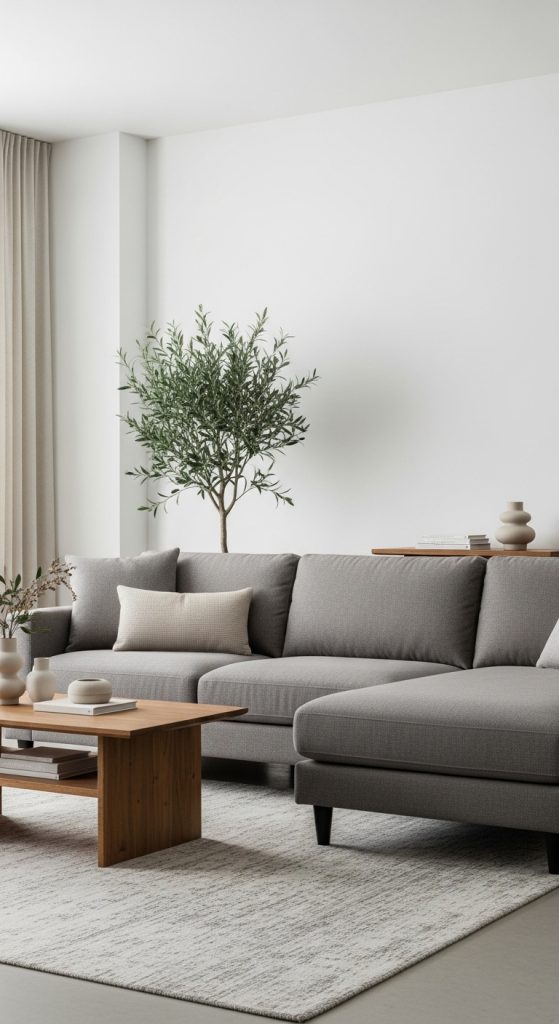
 19 Cozy and Affordable Small Living Room Ideas for Apartments
19 Cozy and Affordable Small Living Room Ideas for ApartmentsFor those who desire a touch more depth or are hesitant about white, a grey sectional is an impeccable alternative. Grey is the ultimate chameleon of neutrals. A light grey can feel just as airy as white, while a darker charcoal can add a moody, sophisticated edge. A grey sofa provides a timeless and versatile anchor that pairs beautifully with virtually any accent color or material, from warm woods to cool metals.
7. Bring in Richness with a Leather Sectional Sofa
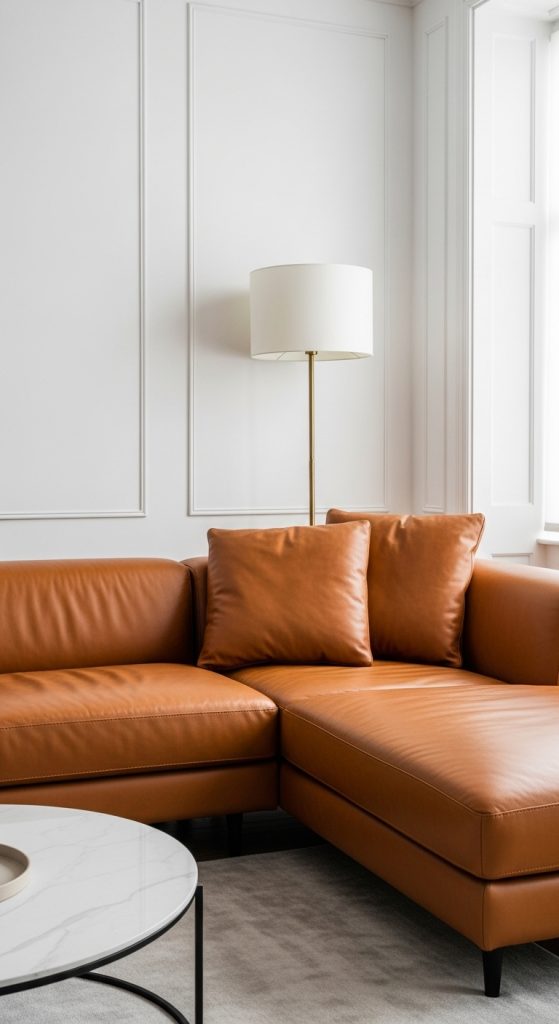
If your version of cozy minimalism leans towards organic luxury, a leather sectional is an investment that pays dividends in style. Look for buttery-soft leather in warm tones like cognac, caramel, or saddle brown. A quality leather sofa develops a beautiful patina over time, gaining character and telling the story of the life lived around it. It introduces a rich texture and warmth that can single-handedly elevate the entire room, creating a focal point that is both inviting and refined.
8. Ground the Space with a Travertine Coffee Table
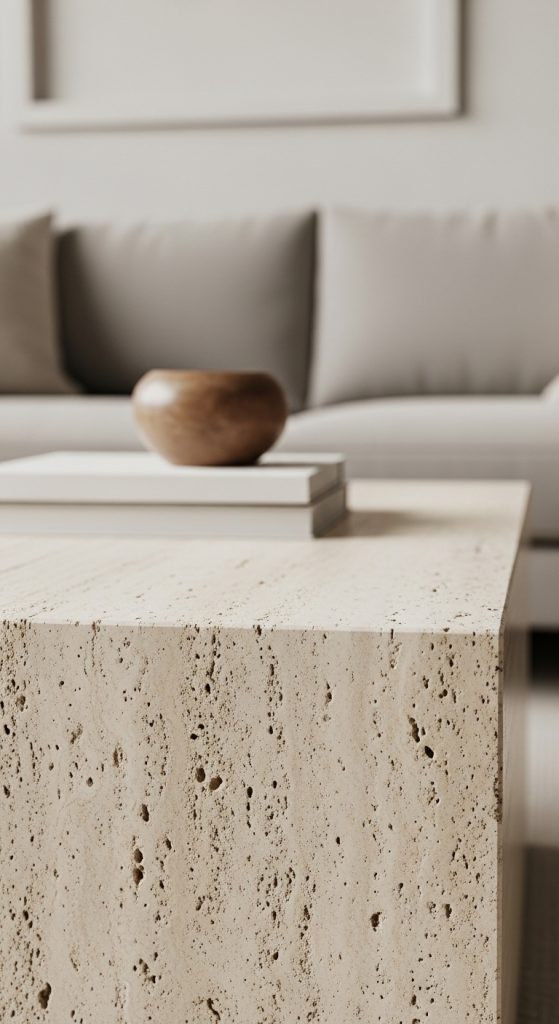
The coffee table is the centerpiece of your seating area, and a travertine table makes a powerful minimalist statement. This natural stone, with its porous texture and warm, earthy tones, has surged in popularity for good reason. A travertine coffee table adds a layer of organic texture and quiet luxury, feeling both ancient and incredibly modern at the same time. Its substantial, sculptural presence can anchor the room without adding visual clutter.
 15 Small Living Room Decor Hacks That Make a Big Impact
15 Small Living Room Decor Hacks That Make a Big Impact9. Add Organic Warmth with a Wood Coffee Table
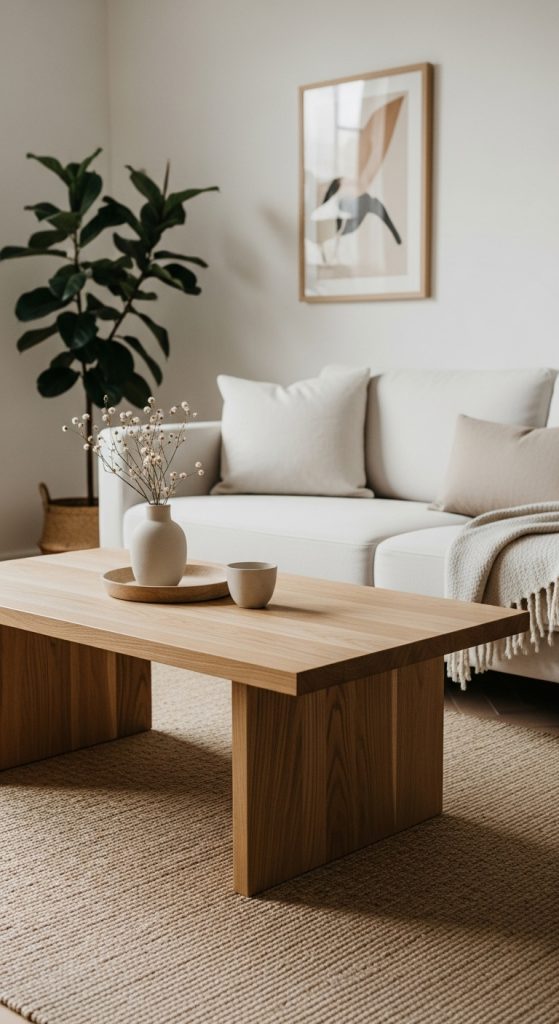
A classic for a reason, a wood coffee table is a surefire way to infuse warmth into a minimalist living room. Whether it's a sleek, mid-century modern design in walnut or a more rustic, reclaimed oak piece, wood brings nature indoors. It pairs beautifully against the softness of a white or grey sofa, creating a pleasing contrast in materials. A simple, well-crafted wood table is a versatile workhorse that will never go out of style.
Layering Texture and Softness: The "Cozy" in Minimalist
A minimalist room is saved from feeling stark by the thoughtful application of texture. These elements invite touch and create a sense of deep comfort.
10. Invite Tactile Comfort with a Boucle Accent Chair
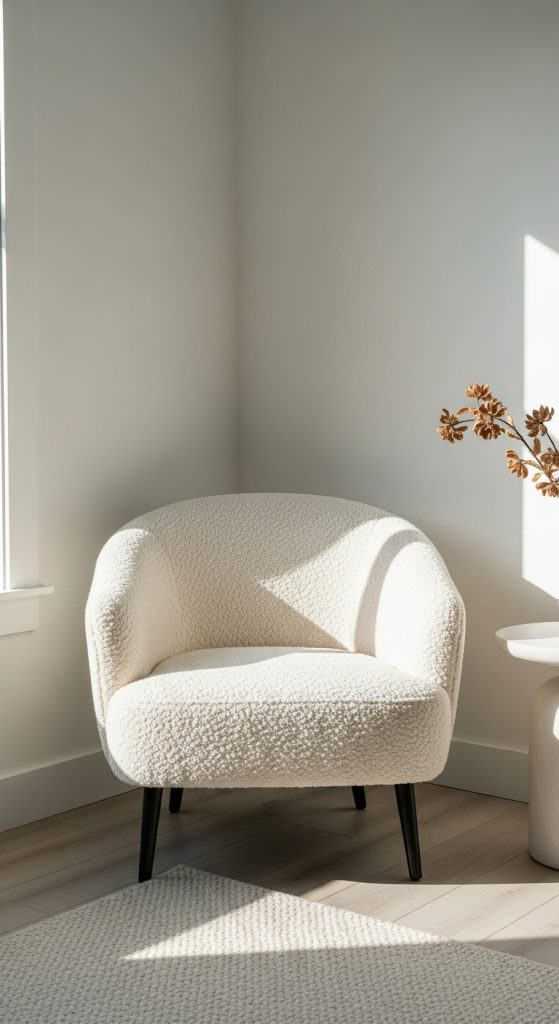
Boucle fabric is having a major moment, and it's easy to see why. This looped, fleecy material is the epitome of cozy. Placing a boucle accent chair in your living room is like adding a warm, textural hug to a corner of the space. Often designed in sculptural, rounded shapes, these chairs serve as a soft counterpoint to the clean lines elsewhere in the room. A swivel version adds a touch of playful functionality.
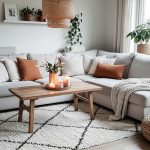 11 Scandinavian Living Room Concepts for Your Nordic Retreat
11 Scandinavian Living Room Concepts for Your Nordic Retreat11. Infuse Timeless Warmth with Leather Accent Chairs

To complement a fabric sofa or complete a conversation area, a pair of leather accent chairs is a classic choice. The rich, warm tones of leather provide an excellent visual and textural contrast to lighter, softer fabrics. A leather chair brings a sense of history and permanence to a room, suggesting a well-curated space that has been built over time.
12. Soften the Light with Neutral, Airy Curtains
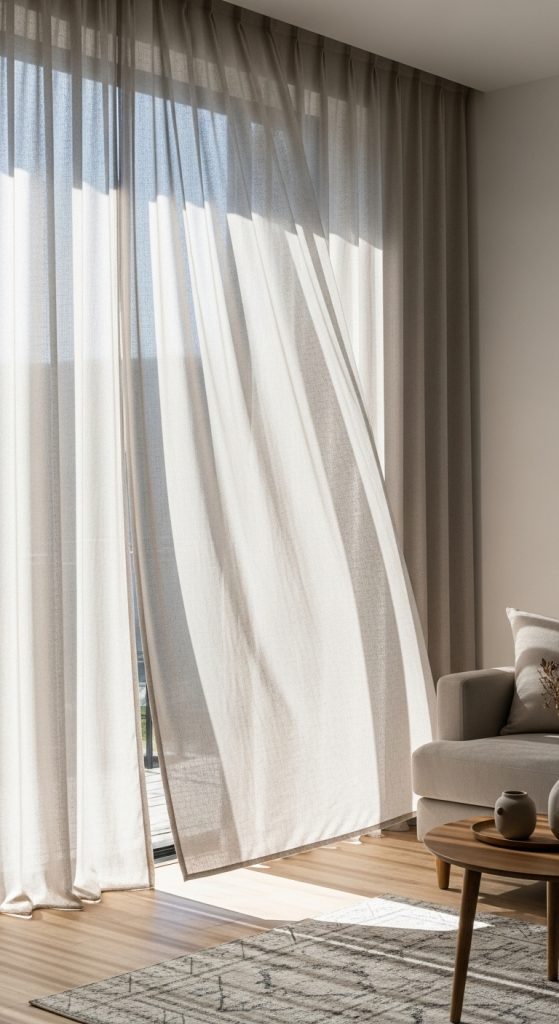
Heavy, dark drapes can make a room feel closed-in. Instead, opt for neutral, airy curtains in materials like linen or sheer cotton. These lightweight curtains don't just cover a window; they beautifully diffuse natural light, casting a soft, ethereal glow across the room. This simple switch enhances the bright, open feel of the space while adding a crucial layer of softness.
13. Incorporate Earthy Textured Ceramics

 19 Black Sofa Inspired Scandi & Industrial Pairings
19 Black Sofa Inspired Scandi & Industrial PairingsSmall details make a big impact. Groupings of earthy, textured ceramic vases and pots add a handmade, wabi-sabi element to your decor. Look for pieces with a matte finish, visible throwing rings, or an intentionally imperfect shape. These objects provide a subtle but essential contrast to the sleek surfaces of modern furniture, reminding us of the beauty in imperfection.
The Personal Touches: Art, Decor, and Storytelling
This is where your minimalist space becomes uniquely yours. Art and decor should be chosen with intention, reflecting your personality without creating clutter.
14. Curate Your Shelves with Minimalist Decor
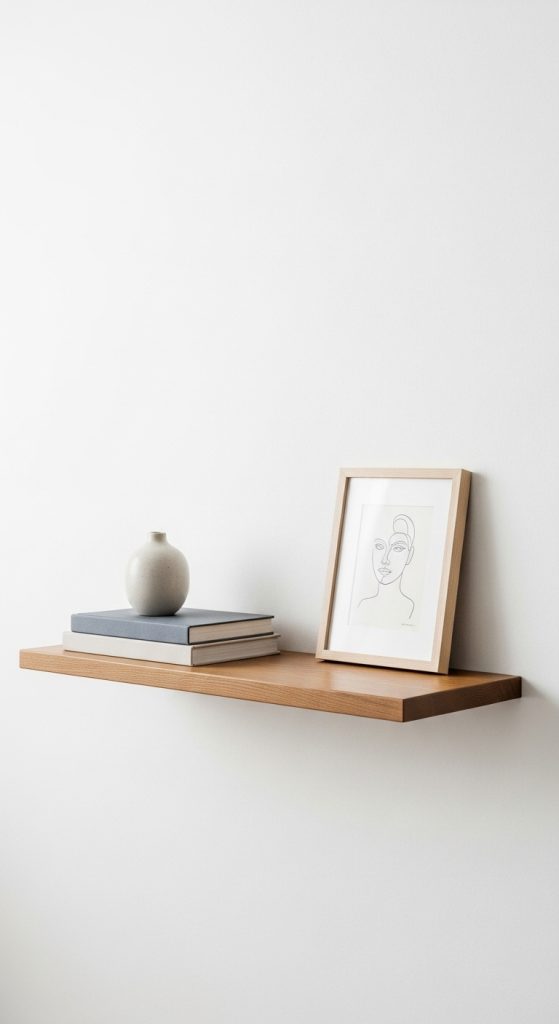
When it comes to shelf styling, the minimalist mantra is paramount: less is more. Resist the urge to fill every inch of space. Instead, treat each shelf as a miniature gallery, curating a few special items like a single beautiful vase, a small stack of art books, or a framed photo. Leaving ample empty space around each object allows its beauty to be fully appreciated and maintains an uncluttered, peaceful aesthetic.
15. Choose Impactful Minimalist Wall Art

 20 Trendy Ways to Style a Living Room with Tall Ceilings
20 Trendy Ways to Style a Living Room with Tall CeilingsLarge, blank walls are an opportunity. Minimalist wall art doesn't have to mean a tiny print in the middle of a huge wall. It can be a large-scale abstract piece with simple forms and a limited color palette, or a piece of line art that makes a statement through its simplicity. The key is to choose art that complements the room's serene mood rather than overwhelming it with busyness or bright, jarring colors.
16. Create a Cohesive Gallery Wall
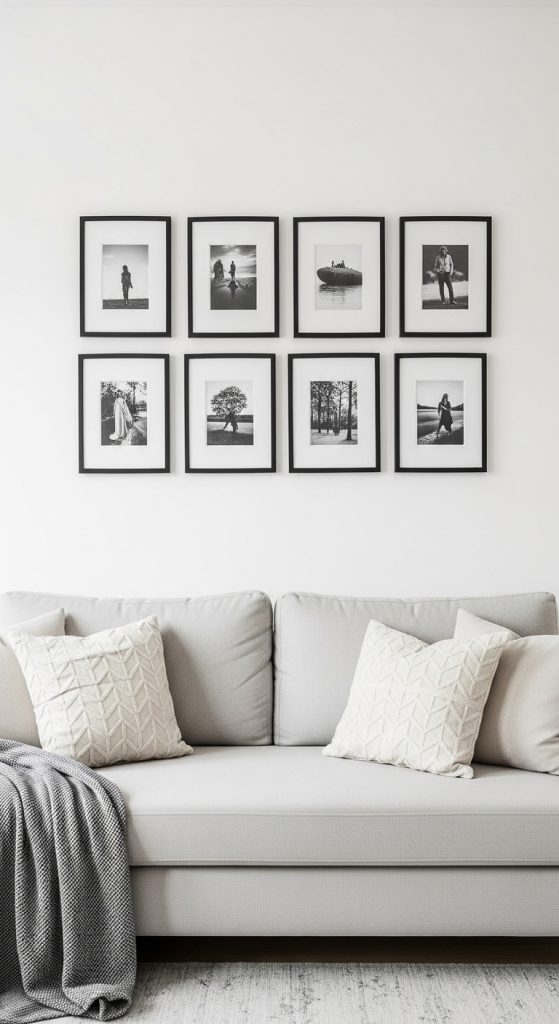
A gallery wall can absolutely exist in a minimalist home, provided it's executed with intention. To maintain a clean look, create cohesion by using identical frames or a strict, unified color palette for all the artwork. A symmetrical grid layout above the couch can look incredibly chic and organized, adding a deeply personal touch without creating visual chaos.
17. Opt for a Flexible Picture Ledge
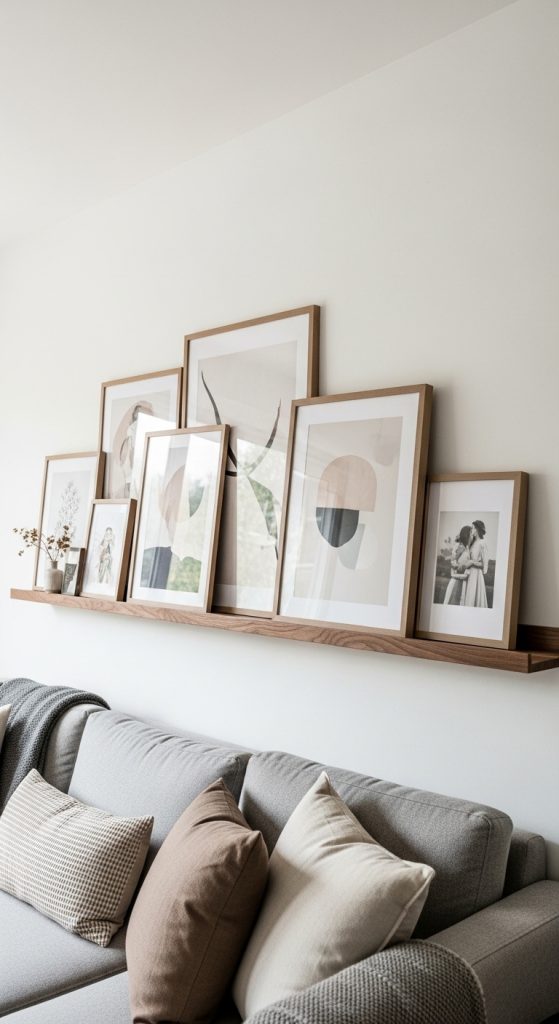
For a more modern and flexible approach to displaying art, consider a picture ledge. A long, shallow shelf mounted on the wall allows you to layer frames of different sizes. The beauty of a picture ledge is its versatility; you can easily swap out art, photos, and small objects whenever you feel like a refresh, no new nail holes required. It encourages a dynamic display that can evolve with your tastes.
 19 Boho Mid-Century Modern Living Room Ideas That Blend Style and Soul
19 Boho Mid-Century Modern Living Room Ideas That Blend Style and SoulBringing Nature Indoors: The Final, Vital Layer
No minimalist space is complete without a connection to the natural world. Organic elements bring life, color, and a sense of grounding calm.
18. Integrate Light Wood Accents
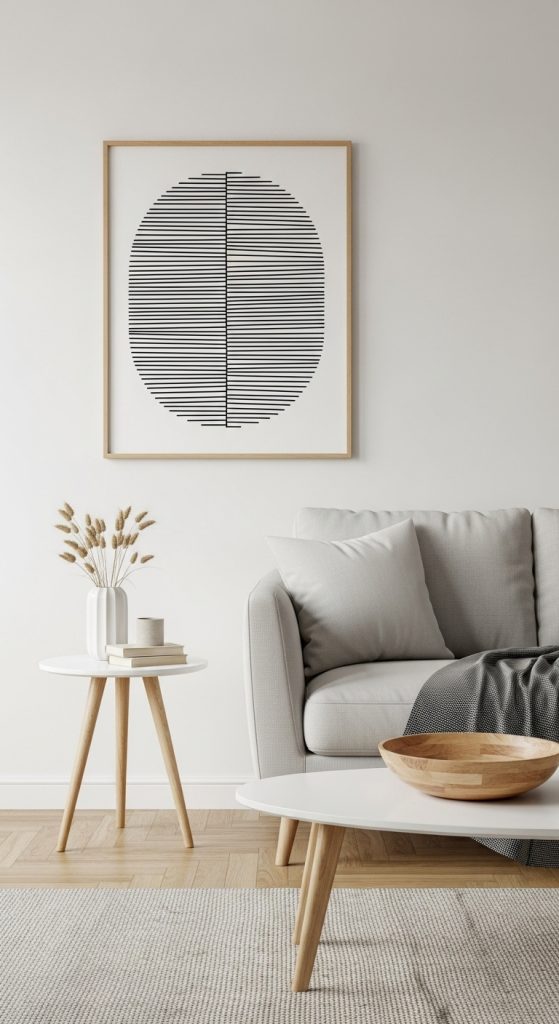
Beyond a coffee table, weave light wood accents throughout the room. This could be in the form of picture frames, the legs of a chair, a decorative bowl, or a small side table. These small touches of natural wood create a cohesive thread of warmth that runs through the space, making it feel integrated and thoughtfully designed.
19. Add Sculptural Greenery with an Olive Tree
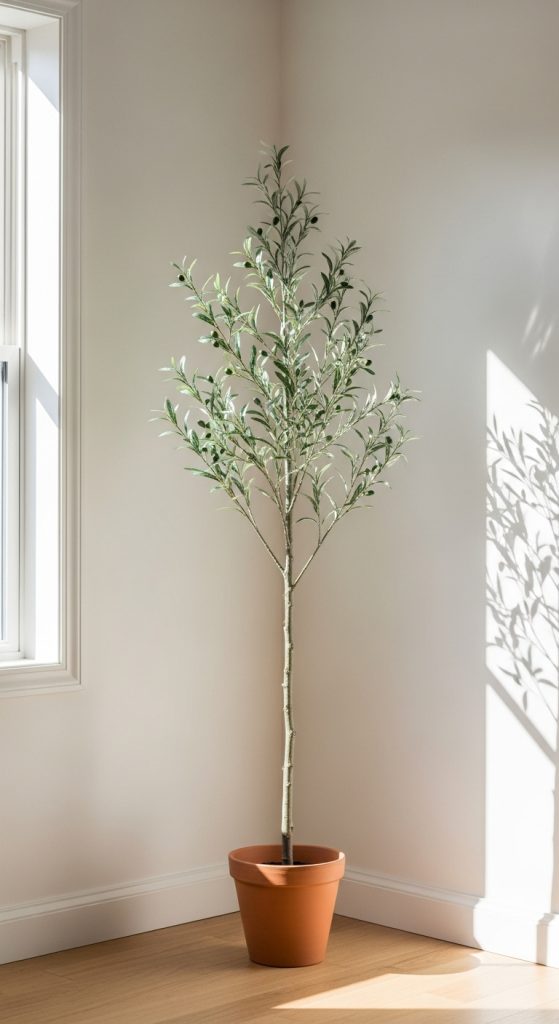
An indoor tree can be a living sculpture. The Faux Olive Tree, in particular, is perfect for a minimalist aesthetic. Its slender trunk, delicate branches, and silvery-green leaves add a touch of Mediterranean elegance and life without being overpowering. Placing one in a sunlit corner instantly breathes vitality into the room.
 25 Neutral Living Room with a Dark Brown Leather Couch
25 Neutral Living Room with a Dark Brown Leather Couch20. Use Pampas Grass for Soft Texture
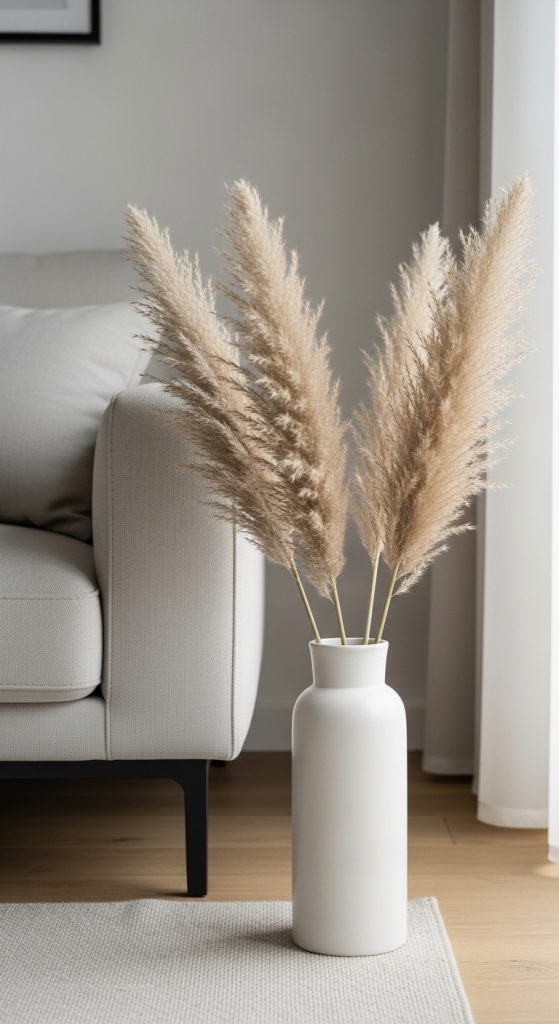
For a low-maintenance touch of on-trend texture, pampas grass is an excellent choice. Placed in a tall, simple vase, its feathery plumes add movement and softness. The muted, wheat-like tones of pampas grass blend seamlessly into a neutral, earthy palette, creating a serene and highly aesthetic vignette.
21. Infuse a Warm, Earthy Color Palette
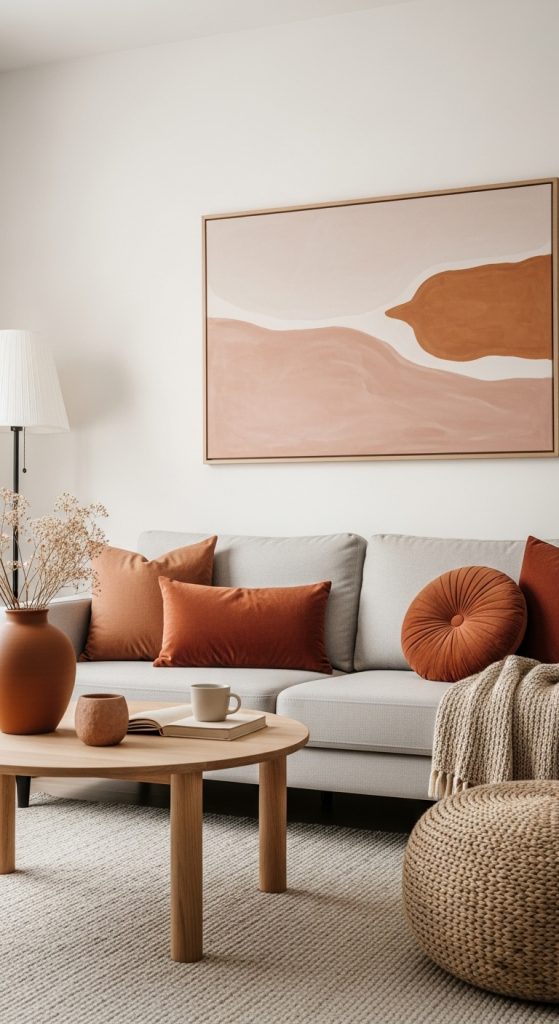
If you crave more color, draw inspiration directly from the earth. Shades of terracotta, rust, clay, and soft ochre can infuse a minimalist living room with incredible warmth and an inviting atmosphere. Use these colors as accents in throw pillows, a blanket, a piece of art, or a feature rug to create a space that feels grounded, organic, and connected to nature.
22. Frame the View with Arched Windows or Mirrors
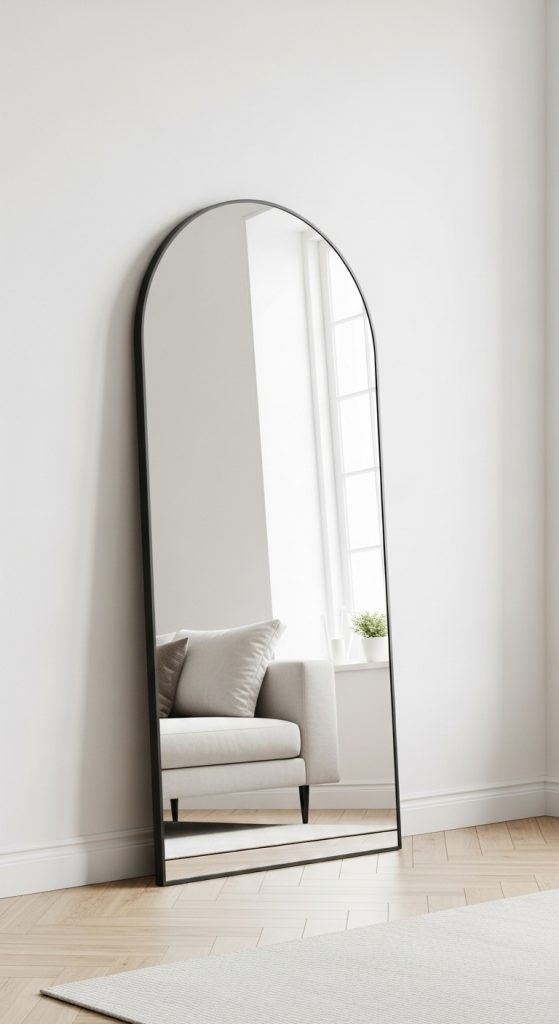
Echoing the grace of arched doorways, an arched mirror or window can serve as a stunning focal point. A large arched mirror not only adds an elegant architectural detail but also reflects light and creates the illusion of more space. It acts like a piece of art, beautifully framing a reflection of your carefully curated room.
Conclusion: Your Personal Minimalist Sanctuary
Creating a minimalist living room is a journey, not a destination. It's not about following a rigid set of rules, but about adopting a mindset of intentionality. Each of these ideas serves as a building block, allowing you to construct a space that is a true reflection of your desire for peace, clarity, and beauty. Ultimately, a minimalist living room is one where you are surrounded only by what you love, what serves a purpose, and what brings you joy. It’s a quiet backdrop for a beautiful life, proving that in design, as in life, simplicity is the ultimate sophistication.

You may be interested in: